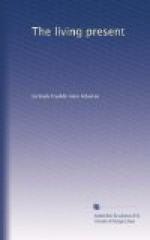Therefore, Mrs. Willsie was thoroughly imbued while a very young girl with the economic ideal, although her mother had planted with equal thoroughness the principle that it was every woman’s primary duty to marry and have a family.
Mrs. Willsie was educated at Madison, Wisconsin, beginning with the public schools and graduating from the University. She married immediately after leaving college, and, encouraged by her husband, a scientist, and as hard a student as herself, she began to write. Her first story followed the usual course; it was refused by every magazine to which she sent it; but, undiscouraged, she rewrote it for a syndicate. For a year after this she used the newspapers as a sort of apprenticeship to literature and wrote story after story until she had learned the craft of “plotting.” When she felt free in her new medium she began writing for the better magazines; and, compared with most authors, she has had little hard climbing in her upward course. Naturally, there were obstacles and setbacks, but she is not of the stuff that ten times the number could discourage.
Then came the third stage. She wrote a novel. It was refused by many publishers in New York, but finally accepted as a serial in the first magazine that had rejected it.
This was The Heart of the Desert. After that followed Still Jim which established her and paved the way for an immediate reception for that other fine novel of American ideals, Lydia of the Pines.
It was about two years ago that she was asked to undertake the editorship of the Delineator, and at first she hesitated, although the “job” appealed to her; she had no reason to believe that she possessed executive ability. The owner, who had “sized her up,” thought differently, and the event has justified him. She ranks to-day as one of the most successful, courageous, and resourceful editors of woman’s magazines in the country. The time must come, of course, when she no longer will be willing to give up her time to editorial work, now that there is a constant demand for the work she loves best; but the experience with its contacts and its mental training must always have its value. The remarkable part of it was that she could fill such a position without having served some sort of an apprenticeship first. Nothing but the sound mental training she had received at home and at college, added to her own determined will, could have saved her from failure in spite of her mental gifts.
Mrs. Willsie, like all women worth their salt, says that she never has felt there was the slightest discrimination made against her work by publishers or editors because she was a woman.
THE END
ADDENDUM
NOTE.—Six months ago I wrote asking Madame d’Andigne to send me notes of her work before becoming the President of Le Bien—Etre du Blesse. She promised, but no woman in France is busier. The following arrived after the book was in press, so I can only give it verbatim.—G.A.




